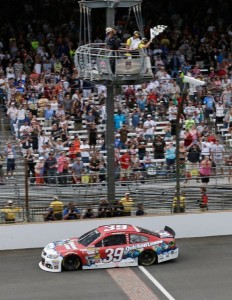by Kent Sterling

Even at the start/finish line as the checkers flew for Hoosier Ryan Newman, there are empty seats. In turn three, there were hundreds of empty rows.
Getting a ticket to the Brickyard 400 wasn’t easy when the race first came to the Indianapolis Motor Speedway, but it is now.
Habits are hard to break, and traditions don’t die easy, but professional sports franchises and race tracks have to fight the feeling that opening the doors to what has always been popular is enough to get people to sacrifice the cash, time, and energy needed to attend a game or race.
Click here to follow Kent on Twitter
The Brickyard 400 is run on the grounds of a magnificent venue enjoyable to visit without a race to attend, but fans who invest their hard earned money and finite energy to share with friends or family want a return on that investment.
While we aren’t the sharpest tacks in the drawer, fans eventually get the point when those we pay to watch show they don’t give a damn about us, and money spent on tickets is sometimes better used for something else.
Here are the 10 reasons less and less fans show up for what used to be a very popular event:
- The cars weren’t designed to run in corners banked at only nine-degrees. Passing is minimal because the turns accommodate only one groove. That’s physics, meaning that the smart guys at the IMS can’t fix that – short of a total rebuild with higher corners. That will never happen.
- Tiregate caused mandatory cautions every 10-12 laps in 2008. Rubber shredded, and so did the waning loyalty of thousands of fans whose ticket renewals required greater thought each year because of the economy and the time demands on the lives of the middle class.
- Local people are used to watching IndyCars circle the two-and-a-half mile oval close to 40 miles per hour faster than Sprint Cup cars. It’s not the drivers’ fault the cars don’t have the ground effects to zip around at 225 mph, but it sure is noticeable.
- IndyCar drivers are significantly less awed by their own images then their NASCAR brothers and sister. If all the drivers were as professional as Jeff Gordon, it might be a little different, but because there is a palpable indifference by NASCAR drivers toward fans compared to the IndyCar guys and girls they appear callous and entitled.
- The Brickyard is won and lost on pit road, which makes for okay television, but 80% of the people sitting in the grandstands at Indy can’t see the pits. Those who can have almost no way of knowing how long the pitstops last. Today’s botched pit stop by Jimmie Johnson’s team cost him the race, but people who were there likely had no idea.
- The Speedway was unable to process fans through lines getting into the Indianapolis 500 in May quickly enough to avoid 90-minute waits as coolers were measured and searched. Security became top of mind again with the disaster at the finish line of the Boston Marathon, and the Speedway was unable to get people in efficiently. The days of being able to learn on the job as fans are moved through the gates are over. People are not going to pay to wait as incompetent and unfocused amateur security staffers chat among each other rather than getting fans through safely and expeditiously.
- The economy has caused enough upheaval over the past decade that people feel their financial lives are in constant peril. The move toward efficiency didn’t just cost people their gigs, but continues to scare the hell out of everyone who kept their job.
- Those with jobs and the disposable income needed to buy tickets to sporting events are working harder and longer. At some point, these people need to rest, and a Sunday afternoon in the summer is a good time for rest.
- The weather was wonderful this weekend, but over the 20 Brickyard weekends in Indy, the high has been in the high 80s or 90s more often than not, and there is no relief on those metal bleachers. Really hot weather, a bunch of beer, and fried food will raise some hell with the heartiest constitution.
- Momentum – either positive or negative – is tough to stop. Ask the Indiana Pacers, if you don’t believe me. The tide is carrying fans out of the market for tickets, and reversing it is going to take a focused and aggressive effort to re-engage them. Drivers will have to do more than sign a few autographs. They are going to have to make bonafide contact with ticket buyers to build a connection. The facility is going to have to be letter perfect in the execution of every detail. That’s not how things have historically worked out there, so a cultural shift is needed. Maybe new president of the IMS Doug Boles is just the guy to attack that challenge.
That’s a long list of gripes, but the bleeding has to stop. Something cool or memorable needs to happen in the Brickyard 400, or the crowds will continue to decline until they finally reach the point of no return. No one wants that, but the work needed to rev this event back up is not for the faint of heart. Giant sections of unpopulated bleachers is unseemly for such a historic venue, and the weather was beautiful this year.
No more excuses, just a lot of hard work ahead.

